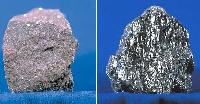
Iron Ore Mining
Get Price Quote
Name : The name iron is from an Old English word isaern which itself can be traced back to a Celtic word, isarnon. In time, the �s� was dropped from usage. Sources : It is estimated that worldwide there are 800 billion tons of iron ore resources, containing more than 230 billion tons of iron. It is estimated that the United States has 110 billion tons of iron ore representing 27 billion tons of iron. Among the largest iron ore producing nations are Russia, Brazil, China, Australia, India and the USA. In the United States, great deposits are found in the Lake Superior region. Worldwide, 50 countries produce iron ore, but 96% of this ore is produced by only 15 of those countries. Iron ore is the raw material used to make pig iron, which is one of the main raw materials to make steel. Due to the lower cost of foreign-made steel and steel products, the steel industry in the United States has had difficult economic times in recent years as more and more steel is imported. Canada provides about half of the U.S. imports, Brazil about 30%, and lesser amounts from Venezuela and Australia. 99% of steel exported from the USA was sent to Canada. Uses : In the United States, almost all of the iron ore that is mined is used for making steel. The same is true throughout the world. Raw iron by itself is not as strong and hard as needed for construction and other purposes. So, the raw iron is alloyed with a variety of elements (such as tungsten, manganese, nickel, vanadium, chromium) to strengthen and harden it, making useful steel for construction, automobiles, and other forms of transportation such as trucks, trains and train tracks. While the other uses for iron ore and iron are only a very small amount of the consumption, they provide excellent examples of the ingenuity and the multitude of uses that man can create from our natural resources. Powdered iron: used in metallurgy products, magnets, high-frequency cores, auto parts, catalyst. Radioactive iron (iron 59): in medicine, tracer element in biochemical and metallurgical research. Iron blue: in paints, printing inks, plastics, cosmetics (eye shadow), artist colors, laundry blue, paper dyeing, fertilizer ingredient, baked enamel finishes for autos and appliances, industrial finishes. Black iron oxide: as pigment, in polishing compounds, metallurgy, medicine, magnetic inks, in ferrites for electronics industry. Substitutes and Alternative Sources : Though there is no substitute for iron, iron ores are not the only materials from which iron and steel products are made. Very little scrap iron is recycled, but large quantities of scrap steel are recycled. Steel�s overall recycling rate of more than 67% is far higher than that of any other recycled material, capturing more than 1-1/4 times as much tonnage as all other materials combined. Some steel is produced from the recycling of scrap iron, though the total amount is considered to be insignificant now. If the economy of steel production and consumption changes, it may become more cost-effective to recycle iron than to produce new from raw ore. Iron and steel face continual competition with lighter materials in the motor vehicle industry; from aluminum, concrete, and wood in construction uses; and from aluminum, glass, paper, and plastics for containers.